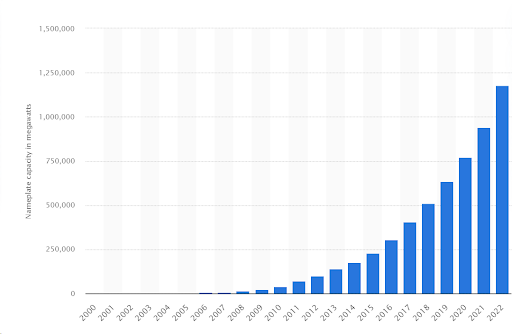Table of Contents
ToggleThe global cumulative solar photovoltaic capacity has grown to 1,177 gigawatts in 2022, with roughly 239 gigawatts of new PV capacity installed in that same year.


Source: Statista
But solar panels are not forever and will eventually deteriorate, calling for solar panel recycling.
The solar panel recycling market growth has also seen a steady increase. Allied Market Research published an estimated 13.1% growth from 2021 to 2030.
But how exactly are solar panels recycled?
In this article, we’ll go through everything you need to know about the process, benefits and where you can recycle solar panels.
Can solar panels be recycled?
Yes, solar panels can be easily recycled. It is because they consist of three components: glass, silicon, and aluminium. These materials have been common in recycling practices for decades and are processed in substantial quantities.
The recycling procedure, when done by experts, is fairly straightforward. The primary challenge lies in the separation of the integrated materials. However, the overall process is facilitated by recycling specialists who excel in this intricate task.
Now some may wonder, how much does it cost to recycle solar panels? Well, just as solar panels are a bit more expensive to install, they also have a higher recycling cost.
But when you look at the bigger picture, it helps save the environment by miles. Before we get into the solar panel recycling process, let’s talk about how long a solar panel can last.


What is the standard lifespan of a solar panel?
Solar panels have a 25-30-year lifespan, although many can continue to function beyond that. As your panels approach the upper limit of their lifespan, they may start showing potential signs of degradation.
It includes physical damage, discolouration, a decline in power output/efficiency, overheating, and more. While solar panel repair options are provided by various manufacturers and installation companies, these may not be cost-effective after the warranty period.
Benefits of recycling solar panels
Making a conscious decision to recycle your solar panels has more pros than just reducing waste. While it is good for the environment, it also contributes to the economy. Here are some benefits of recycling solar panels:
- Resource conservation: Solar panels contain valuable materials like silicon, glass, aluminium, and other metals. Recycling these reduces the need to extract and process new raw materials. This conservation of resources helps alleviate the environmental impact of mining and extraction activities.
- Energy savings: Recycling requires less energy than manufacturing new products from raw materials. Therefore, reusing materials from old solar panels reduces the overall energy consumption compared to producing new panels.
- Greenhouse gas emission reduction: The recycling process generates fewer greenhouse gas emissions compared to the production of new solar panels. By recycling, the carbon footprint that comes from manufacturing and transporting raw materials is reduced.
- Job creation: The recycling industry, including the recycling of solar panels, creates jobs for many. This contributes to the economy of a country while promoting sustainable employment opportunities.
Solar panel recycling process
When solar panels die, they pass through a solar panel recycling machine. It helps to delaminate, separate, extract and purify the materials that make up a solar panel. Let’s explore the steps individually below.
Delamination
The first step involves separating the different layers and materials that make up the solar module. Solar panels consist of multiple layers, including an aluminium frame, glass, encapsulant, solar cells, and a back sheet.
Delamination focuses on breaking down these layers to facilitate material separation. This process uses a variety of methods, such as:
- Mechanical treatment: Methods like cutting or crushing are often employed to break the solar panels into smaller pieces. This initial step aims to weaken the bonds between the layers.
- Heat treatment: Heat can be applied to soften the encapsulant material, making it easier to separate. This is particularly important to ensure the complete removal of the encapsulant from other components like the solar cells.
- Chemical treatment: In some cases, chemical treatments dissolve or weaken the adhesive properties of the encapsulant. This can prove to be more effective if heat treatment doesn’t work.
- Manual separation: Manual efforts may also be required to peel apart the layers once the other treatments are applied. Skilled technicians typically separate the layers carefully to preserve the recovered materials.
Material separations
Out of the three steps involved in solar panel recycling, separating materials is the most elaborate. There are a few methods applied during this step before the components are ready for extraction.
- Screening and sorting: After crushing, panels undergo screening to separate materials based on size. This step helps in isolating smaller particles and allows for more precise sorting.
- Magnetic separation: Magnetic separation is commonly employed to separate ferrous metals from other materials. Magnets attract and separate metals, such as steel or iron, often present in the solar panel’s frame or back sheet.
- Eddy current separation: Eddy current separators segregate non-ferrous metals from shredded material. An eddy current creates a magnetic field that repels metals like aluminium. This causes them to eject from the material stream.
- Air classification: Air classifiers use air currents to separate lighter materials like plastic encapsulants from heavier materials like glass and metals. This helps in further refining the separation process.
- Density separation: Separation based on density involves using methods like floatation to separate materials with different densities. This can be particularly useful for separating silicon wafers from encapsulant materials.
- Manual sorting: In some cases, manual sorting may be necessary, especially for challenging components to separate using automated methods. Skilled workers may identify and manually extract specific materials from the processed material stream.
Material extraction and purification
The final step in solar panel recycling is material extraction and purification. In layman’s terms, it means refining the recovered components. This helps to prepare them for reuse in new manufacturing processes.
The materials must go through this step before being reused. This is mainly because of the creation of impurities during the delamination process. Purification ensures the materials are clean and ultimately increases their market value.
How to dispose of used solar panels?
If your solar panels have reached the end of their life and their warranty has expired, your best bet is to dispose of them. However, it is important to do it properly to reduce negative environmental impact and minimize waste. Here are the steps to dispose of used solar panels:
- Decide where to recycle: Identify recycling facilities or electronic waste recycling centres in your locality that accept solar panels. Ensure these facilities adhere to environmental standards and can handle the solar panel recycling process.
- Dismantle solar panels: Next, carefully dismantle the solar panels from their mounting brackets. Then, remove any possible components and separate them respectively. Doing so helps in reducing the volume of waste when transporting.
- Safely transport to facility: Use appropriate packaging or containers to prevent breakage. If possible, secure the services of a professional transporter experienced in handling electronic waste.
- Document and keep records: Lastly, don’t forget to maintain thorough documentation throughout the disposal process. Keep records of the recycling facility details, transportation methods, and any certificates provided by the facility. This will help if you require proof of compliance by local authorities.
- Engage a professional: Alternatively, you can engage a professional for a hassle-free disposal process. Such professionals possess the expertise to handle everything, from dismantling to transportation and recycling. It is optional but can be convenient if you’re busy.
Where to recycle solar panels?
Most cities and countries have now identified specific disposal and recycling facilities equipped to handle the unique needs of solar panels. This ensures both environmental sustainability and effective waste management. Following are the various options available for recycling solar panels:
- Solar panel manufacturers: Some manufacturing companies have take-back programs or partnerships with recycling facilities. The latter also means you may get discounts when repurchasing a new solar panel with the same manufacturer.
- E-waste collection events: Check for local electronic waste collection events or programs organized by municipalities or environmental organizations. These events provide a convenient and responsible way to recycle your solar panels.
- Scrap solar panel recycling companies/government-authorised centres: Various companies specialize in recycling solar panels. They have the expertise and facilities to dismantle and recycle various components efficiently. Additionally, governments in many countries encourage recycling and other sustainable activities to minimise e-waste. You may look for similar companies or centres within your city/locality and consult them regarding the logistics involved.
- Donate or resell: To save your panels from the landfill, donate or resell them. Do this through reselling platforms like Carousell or in Facebook groups. Some individuals will know how to fix these panels, getting them to work again.
Conclusion
The process of solar panel recycling is a critical step towards ensuring a sustainable future in renewable energy. As we embrace solar power, it’s equally important to address the end-of-life management of solar panels.
The recycling process not only mitigates environmental impacts but also contributes to the circular economy. By investing in and improving solar panel recycling techniques, we can reduce waste, conserve resources, and support the transition to a more sustainable and responsible energy landscape.
This commitment to recycling underscores the true essence of solar energy, harnessing natural resources responsibly and efficiently for a cleaner, greener planet.




